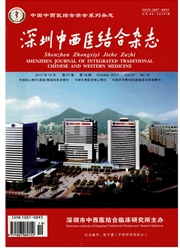

 中文摘要:
中文摘要:
目的探讨白细胞介素1α(IL-1α)基因单核苷酸多态性(SNP)与甲型H1N1流感易感性的关系。方法从IL-1α基因启动子区域中选取4个SNP位点rsl800587、rs2856836、rs2856838、rs3783525,针对以上位点建立基于飞行时间质谱分析技术(TOF—MS)鉴定SNP的方法,对167例H1N1流感患者(H1N1组)和192例健康对照人群(对照组)进行检测。确定各SNP位点的等位基因和基因分型;对比两组等位基因和各基因型的频率。结果rsl800587、rs2856836、rs2856838位点具有T和C两种等位基因,包括Tr、TC、CC3种基因型。rs3783525具有A和T两种等位基因,包括AA、AT和Tl 3种基因型。HINl组和对照组rsl800587位点的等位基因频率差异有统计学意义(X2=12.69,P=0.000,OR=2.424,95%CI=1.472~3.993),rs2856836,rs2856838,rs3783525等位基因频率在H1N1组和对照组中差异则无统计学意义。H1N1组rsl800587位点CC纯合子频率低于对照组[72.5%(121/167)比87.0%(167/192),P〈0.05],杂合子(TC)频率高于对照组125.1%(42/167)比12.5%(24/192),P〈0.05],而两组Tr纯合子频率差异则不具有统计学意义。H1N1组rs2856836位点杂合子(TC)频率高于对照组[25.7%(43/167)比17.2%(33/192),P〈0.05],TT基因型与CC基因型频率在两组间差异均没有统计学意义。rs2856838位点对照组TT纯合子频率低于H1N1组[4.2%(8/192)比10.8%(18/167),P〈0.05],其余2种基因型Tc与cc在两组间差异没有统计学意义。H1N1组rs3783525位点TT纯合子频率高于对照组[21.0%(35/167)比13.0%(25/192),P〈0.05],两组间的另两种基因型TC与cc差异也没有统计学意义。结论IL-1α仅基因多态性位点rsl800587、rs2856836、rs2856838、rs3783525与甲型H1N1流感易感性相关。
 英文摘要:
英文摘要:
Objective To determine the association between interleukin-1 alpha (IL-lα) gene single nucleotide polymorphism (SNP) and susceptibility to type A H I N l influenza. Methods Four SNPs (rs1800587, rs2856836, rs2856838 and rs3783525) were selected from IL- lα promoter region for subsequent establishment of the methodology for identifying SNP based on time of flight-mass spectroscopy (TOF-MS), which was employed to genotype patients with H1Nl(n=167) and healthy controls(n=192). The alleles of respective SNP were genotyped for comparison on their frequency. Results The rs1800587, rs2856836 and rs2856838 SNPs consisted of T and C alleles and the genotypes of TF, TC and CC. Bycontrast, the rs3783525 included A and T alleles that comprised of AA, AT and Tr genotypes. The difference in allele frequency between H 1N 1 groups and healthy controls reached statistical signifieance (Xz= 12.69, P=0.000, OR--2.424, 95%CI: 1.472-3.993), whilst the between-group difference in allele frequency was not statistically significant for rs2856836, rs2856838 and rs3783525. Patients with H1N1 yielded a lower allele frequency of CC homozygote for rs1800587172.5%(121/167) vs 87.0%( 167/192), P〈0.05] yet higher frequency of TC heterozygote[25.1%(42/167) vs 12.5%(24/192), P〈0.05]. There was no significant difference in the frequency of TT homozygote. A higher frequency of TC heterozygote for rs2856836 [25.7% (43/167) vs 17.2%(33/192), P〈0.05] was noted in patients with H1N1, in whom the frequency of TT and CC genotypes did not differ statistically. Patients with H1N1 were linked to a higher frequency of TT homozygote for rs2856838 [4.2% (8/192) vs 10.8% (18/167) , P〈0.05] yet did not differ markedly in the genotypes of TC and CC. Similarly, a higher frequeney of TT homozygote for rs3783525 was found in patients with H1N1 [21.0%(35/167) vs 13.0%(25/192), P〈0.05], who did not evidence a considerable difference in genotypes TC and CC for two miscellaneous alleles. C
 同期刊论文项目
同期刊论文项目
 同项目期刊论文
同项目期刊论文
 IP-10and MIG are compartmentalized at the site of disease during pleural andmeningeal tuberculosis a
IP-10and MIG are compartmentalized at the site of disease during pleural andmeningeal tuberculosis a A functional single-nucleotide polymorphism in the promoter of the gene encoding interleukin 6 is as
A functional single-nucleotide polymorphism in the promoter of the gene encoding interleukin 6 is as Gamma Interferon Immunospot Assay of Pleural Effusion Mononuclear Cells for Diagnosis of Tuberculous
Gamma Interferon Immunospot Assay of Pleural Effusion Mononuclear Cells for Diagnosis of Tuberculous Allele-SpecificInduction of IL-1β Expression by C/EBPβ and PU.1 Contributes to IncreasedTuberculosis
Allele-SpecificInduction of IL-1β Expression by C/EBPβ and PU.1 Contributes to IncreasedTuberculosis Discriminating Active Tuberculosis from Latent Tuberculosis Infection by flow cytometric measurement
Discriminating Active Tuberculosis from Latent Tuberculosis Infection by flow cytometric measurement 期刊信息
期刊信息
